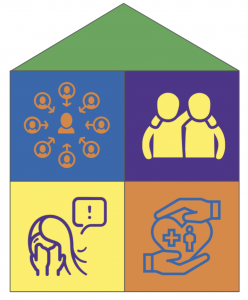The Four Foundational Concepts

People do not choose to be homeless. There is invariably an event (or a series of events) that the individual experiences that lead to a loss of housing. This event then leads to the individual being homeless which involves situations that are unpleasant, unhealthy, and unsafe. This trajectory occurs beyond the control of the individual and can be very distressing. Homelessness is a very complex issue and different for each individual.
There are four foundational concepts that we will be visiting and revisiting throughout this book. They are critical to understanding the complexity of homelessness in Canada. These include:
Person-centred care
 Person-centred care is not just about giving people whatever they want or just providing information. It is about considering people’s desires, values, family situations, social circumstances, and lifestyles. Also, it is about interacting with the person as an individual and working together to develop appropriate solutions with them. It involves being compassionate, thinking about things from the person’s point of view, and being respectful of the person’s wishes and choice.
Person-centred care is not just about giving people whatever they want or just providing information. It is about considering people’s desires, values, family situations, social circumstances, and lifestyles. Also, it is about interacting with the person as an individual and working together to develop appropriate solutions with them. It involves being compassionate, thinking about things from the person’s point of view, and being respectful of the person’s wishes and choice.
Social determinants of health
 There are many factors that influence health and well-being. Historically, we have focused on the physical factors such as age, sex, genetics, and various lifestyle or behavioural factors. In order to truly understand health and well-being we need to broaden this lens to include the social and economic factors that influence health. The social determinants of health (SDOH) are related to an individual’s place in society (income, education, employment) and to an individual’s experiences of discrimination, racism, and historical trauma.
There are many factors that influence health and well-being. Historically, we have focused on the physical factors such as age, sex, genetics, and various lifestyle or behavioural factors. In order to truly understand health and well-being we need to broaden this lens to include the social and economic factors that influence health. The social determinants of health (SDOH) are related to an individual’s place in society (income, education, employment) and to an individual’s experiences of discrimination, racism, and historical trauma.
The main social determinants of health include:
-
-
- Aboriginal Status
- Early life
- Education
- Employment and working conditions
- Food security
- Gender
- Health care services
- Housing
- Income and its distribution
- Social safety net
- Social exclusion
- Unemployment
-
(Raphael, 2016)
Trauma-informed care
 This is an approach in the human service field that assumes that an individual is more likely than not to have a history of trauma and recognizes that symptoms of trauma play a role in an individual’s life. The intention of Trauma-Informed Care is not to treat symptoms or issues related to sexual, physical or emotional abuse or any other form of trauma but rather to provide support services in a way that is accessible and appropriate to those who may have experienced trauma.
This is an approach in the human service field that assumes that an individual is more likely than not to have a history of trauma and recognizes that symptoms of trauma play a role in an individual’s life. The intention of Trauma-Informed Care is not to treat symptoms or issues related to sexual, physical or emotional abuse or any other form of trauma but rather to provide support services in a way that is accessible and appropriate to those who may have experienced trauma.
Social inclusion
 This concept involves understanding the way in which individuals are made part of structured social relationships and groups. It is a process where all individuals have the opportunity to engage in various social, economic, and political systems. Research has shown that a feeling of belonging to a community and social inclusion are central to mental health. Belonging to a network of supportive relationships is protective of good health and positive wellbeing.
This concept involves understanding the way in which individuals are made part of structured social relationships and groups. It is a process where all individuals have the opportunity to engage in various social, economic, and political systems. Research has shown that a feeling of belonging to a community and social inclusion are central to mental health. Belonging to a network of supportive relationships is protective of good health and positive wellbeing.

